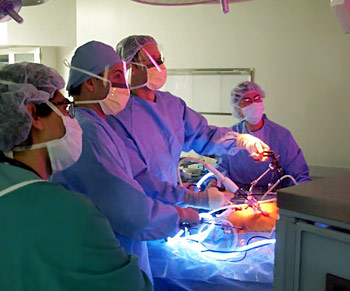 Weight loss surgery generally results in greater Weight Loss than conventional treatment, and leads to improvements in quality of life and obesity related diseases such as hypertension and diabetes. Laparoscopic surgery has revolutionized Metabolic surgery by greatly reducing problems associated with conventional surgery and is now the treatment of choice.
Weight loss surgery generally results in greater Weight Loss than conventional treatment, and leads to improvements in quality of life and obesity related diseases such as hypertension and diabetes. Laparoscopic surgery has revolutionized Metabolic surgery by greatly reducing problems associated with conventional surgery and is now the treatment of choice.
Procedures
Predominantly Malabsorptive Procedures
Although also reducing stomach size, these operations are based mainly on malabsorption. These include Biliopancreatic Diversion, Jejuno-ileal bypass etc.
Predominantly Restrictive Procedures
This kind of surgery primarily reduces stomach size such as Laparoscopic Adjustable Gastric Banding (LAGB), Sleeve Gastrectomy, Gastric bypass, Sleeve gastrectomy with Duodenal Switch etc.
However, Metabolic surgery cures the patient of high blood pressure and diabetes mellitus which disappears even before the weight loss starts. Normally, patients lose upto 60-70% of their excess body weight and it is not uncommon to find patients of 200kg weight coming down to 80kg in less than a year after surgery. Patients who have undergone these surgeries are usually recommended lifelong vitamin supplements.
Endoscopic procedures are rapidly gaining popularity due to inherent advantages of avoiding surgery, high safety, reversibility and rapid short term weight loss of 20-30kg. The commonest of these procedures is the Intragastric balloon placement. Intragastric balloons such as the BIB System are non-surgical, non-pharmaceutical aids in the treatment of obesity. The balloon partially fills the stomach and patients report that they have a feeling of fullness. The balloon is placed into the stomach through endoscopy. Once the balloon is inside the stomach, it is immediately filled with sterile saline through a small filling tube (catheter) attached to the balloon. In conjunction with a supervised diet and behaviour modification program, it can help the patient achieve the health and aesthetic benefits associated with weight loss. It may be particularly useful for people considered too overweight or at increased risk for vital surgery. The balloon is usually removed after six months and patients can keep the weight from coming back by modifying their diet and lifestyle subsequently.
All modalities of treatment of the problem of obesity require consistent efforts on the part of the patient. A healthy country is built on its healthy citizens and we must all strive to work towards a fit society by regular exercise and judicious diet management to reverse the pandemic of obesity.
See Also
Weight Loss Methods
Contributed By Dr Amit Thadhani MS, FMAS




